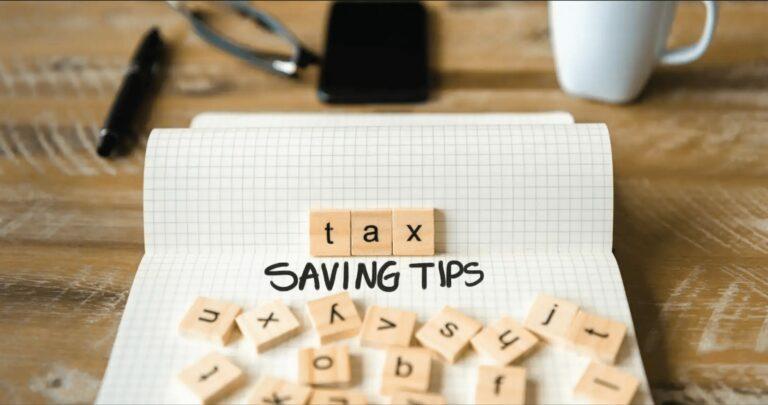6 Best Tax Saving Strategies 2022

These six tax-saving strategies will help you save money at the end of the year.
As the year nears its end, now is the time to ensure your wealth plan maximizes your tax savings.
You still have time to use some of these strategies to strengthen your financial position if you’ve waited until now. We help our clients reduce their taxes year-round.
A good understanding of taxes will help you plan properly when some of these involve using the tax code to your advantage.
Consider “Bunching” as a Tax-Smart Move
The strategy, also known as “lumping and clumping”, allows you to increase your deductions so that you fall into a lower tax bracket overall.
Ordinary income tax savings could be thousands, if not tens of thousands if you make this choice.
Depending on your filing status, you need to get over the hurdle of the standard deduction in order to itemize your tax deductions.
Here in Washington, DC, mortgages, and philanthropy both help a lot. This lesser-known tactic can also be used.
To maximize your tax benefit, bunching refers to grouping and accelerating your deductions into one tax year. Based on your filing status, here are the 2022 standard deduction amounts:
Married – $25,900
Single or married, filing separately – $12,950
Head of household – $19,400
It is possible to deduct the following expenses as itemized deductions, but not all:
- Medical and dental expenses
- Deductible taxes
- Qualified mortgage interest, including points for buyers
- Investment interest on net investment income
- Charitable contributions
- Casualty, disaster, and theft losses
Review your tax return from last year and compare it to your projections for 2022. This strategy can still be implemented.
By doing so, you may be able to lower your taxable income altogether. You should consult your accountant and financial planning team before utilizing this strategy since it may be complex.
Harvesting tax losses
Despite the fact that many families work with financial professionals, this strategy is incredibly underutilized. Investments that lose value below their purchase price can result in capital losses that are maintained on investors’ records.
It is especially useful during years like this one when markets have depreciated significantly from their January levels. Selling an investment when its value has fallen seems counterintuitive. Aren’t those losses permanent?
By doing this correctly, you’ll simultaneously rebalance your portfolio in a way that will allow you to recover once the market recovers as well. Therefore, you will be able to book the savings and reinvest the funds, riding the market’s eventual rise.
You’ll be able to offset your capital gain and possibly eliminate your taxes on the growth of the investment rather than paying taxes on the regrowth. Our clients have benefited greatly from this strategy this year, and the tax savings are substantial.
Be aware of the wash-sale rule when doing this. Reinvesting in the same investment after selling it to book tax savings is prohibited by the IRS. It is a sophisticated strategy that should be monitored carefully to ensure that it does not break rules or disrupt the portfolio inadvertently.
Here is a quick checklist for harvesting tax losses:
- Make sure your asset allocation is correct. Do I need to rebalance?
- Is tax-loss harvesting going to restore your allocation to the retirement plan’s effective target allocation?
- Ensure that your assets are tax-managed. Make use of tax-lot swaps.
2. Check for realized gains/losses. Do you currently have a realized gain or loss?
- Capital gains season is here for mutual funds. This is the time of year when most mutual funds start passing on distributions and taxes to investors.
- Does a capital loss carryforward need to be considered?
- Over the next few years, do you anticipate any large gains?
- Do you have any options for resetting the tax lot if you swap an investment at a gain?
3. In what tax bracket do you currently pay long-term capital gains? Is it zero percent?
- It may be better to realize gains rather than harvest losses.
4. In what tax bracket do you expect to be in the future? Is it higher or lower than the current level?
5. Are there any state-specific issues that need to be addressed?
- The capital loss carryforward provisions are not available in PA and NJ, for instance.
6. How can tax-loss harvesting help you in other areas?
- Capital gains distributions from mutual funds can result in significant taxes.
- It is important to keep your adjusted gross income (AGI) below Medicare surtax thresholds, especially if you are on Tricare.
7. Consider long-term planning, such as step-ups in basis tax provisions and gifting.
8. Charitable planning and loss harvesting should go hand in hand.
- Turn around and gift the cash to a DAF (see below) after harvesting a loss.
9. It’s not always better to have more. Losses should not be wasted.
Utilizing Donor-Advised Funds (DAFs) strategically
A donor-advised fund (DAF) is a charitable vehicle that allows you to organize your charitable mission to support organizations that matter to you. You can claim an immediate tax deduction for DAF contributions when you contribute cash, securities, or other allowable assets.
The assets can then be invested for tax-free growth, and charitable grants can be recommended.
Donations of appreciated securities or cash are popular choices among families. You can significantly reduce your taxes by giving securities.
As an example, gifting stocks with a cost-basis of $5,000 and a value of $15,000 could save most people $1,500 in taxes because you won’t have to realize the capital gain ($10K).
Your savings would exceed $2,000 if your spouse is high earner or you have several sources of income and are in the highest federal marginal tax bracket.
Also, you still get the full $15K deduction for charitable contributions, so you don’t have to pay taxes on that amount. A DAF is an excellent tax-saving tool for families. Make sure you coordinate this with your advisors as always.
Your Retirement Savings Can Be Maximized
In order to maximize your retirement savings, you should put as much money into the account as possible. Traditionally, TSP contributions are funded with pre-tax dollars, lowering your taxable income for the year and allowing for compound growth.
Investing in the Roth TSP also provides growth, but you do not get a tax benefit. For determining whether you should contribute to a Roth TSP or traditional TSP, you should model your projected taxable brackets for now and in the future.
Contribution limits for 2022 for the TSP are $20,500 for those under 49 and $27,000 for those over 50. Make sure you max out your statements by the end of the year. Make adjustments as necessary.
You can contribute to an individual retirement account (IRA) in addition to the TSP. Limits for 2022 are $6,000 for those under 49 and $7,000 for those 50 and older. Traditional IRA contributions are also deductible, and Roth IRA contributions are tax-free.
Understanding the tax code pertaining to IRA contributions is imperative. It is important to note that not everyone is eligible for a Roth IRA deduction, and not everyone is allowed to claim the deduction for Traditional IRA contributions.
Both may be phased out depending on your tax status and your household’s overall taxable income. Non-deductible Traditional IRA contributions and backdoor Roth contributions would still be allowed. Both require careful planning to avoid IRS trouble.
Using Qualified Charitable Distributions (QCDs)
When you reach 72 years of age (formally 70.5 years old; changed by the SECURE Act), you have to take a certain amount out of your retirement account every year, which requires you to pay taxes.
You must remember that every dollar you withdraw from a non-Roth retirement account is taxable as ordinary income. If you are 72 years old and charitably inclined, then you might want to consider Qualified Charitable Distributions (QCDs).
Donations to qualified charities can be counted as Qualified Charitable Distributions by the IRS. Any portion of your QCD counts toward your RMD, and you don’t owe taxes on it. Doing something good for a cause while also doing something good for yourself is a win-win situation.
You should make sure that your donation goes directly to the charity. You cannot take custody of the distribution or risk disqualification.
Roth Conversions are a Good Option
When you’re eligible, Roth IRA distributions are tax-free. In retirement, tax-free cash can help you reduce your overall lifetime tax liability, even if tax rates rise.
In addition, there is no required minimum distribution (RMD) for Roth IRAs. It is possible for non-spouse beneficiaries of Roth IRAs to continue compounding tax-free for an additional decade after inheriting the account.
Tax projections are essential when considering a Roth conversion. Your financial planner and accountant or tax preparer should discuss this regularly as you enter retirement.
There is still time for you to implement these strategies before the end of the year since tax planning is a year-round process that requires careful planning.
As Justice Learned Hand once said, “…anyone may arrange his affairs in such a way as to minimize his taxes; he is not bound to choose that pattern which best pays the treasury. There is no public duty to pay more than the law requires: taxes are enforced exactions, not voluntary contributions.” It sounds pretty good to us. If we can help you achieve a better financial future, please let us know. Best wishes for your planning.


